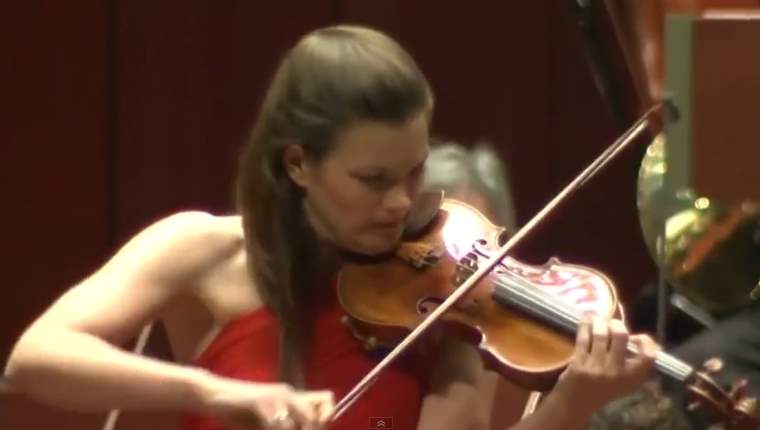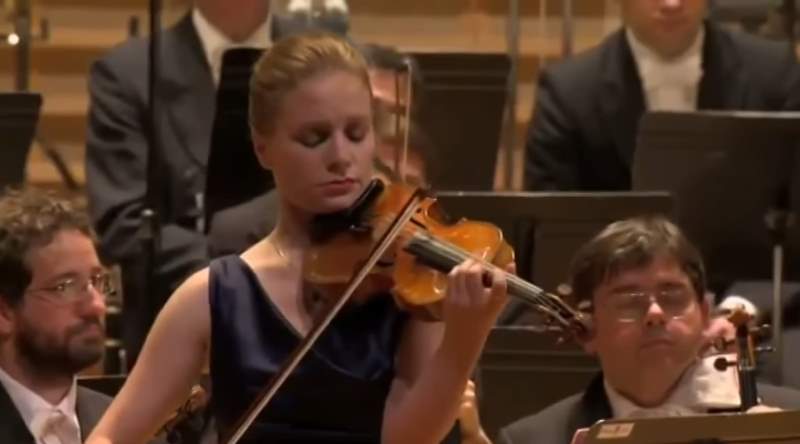Accompanied by the Moscow Philharmonic Orchestra, renowned Soviet classical violinist David Oistrakh performs Pyotr Ilyich Tchaikovsky’s Violin Concerto in D major, Op. 35. Conductor: Gennady Rozhdestvensky. Written in 1878, the piece is one of the best-known violin concertos and is considered one of the most technically difficult works for the violin. Performed and recorded in the Tchaikovsky Hall in Moscow on September 27, 1968.
Encore: the second movement (Andante) of Violin Concerto in A minor BWV 1041 by Johann Sebastian Bach. In the Andante, Bach uses an insistent pattern in the ostinato bass part that is repeated constantly in the movement. He focuses on the variation in harmonic relations.
Tchaikovsky’s Violin Concerto
Tchaikovsky’s Violin Concerto in D major, Op. 35 is considered one of the most challenging and technically demanding pieces in the classical music repertoire. It was composed in 1878 and premiered in Vienna in 1881, with the virtuoso violinist Adolf Brodsky as the soloist. The concerto is renowned for its soaring melodies, technical fireworks, and intense emotional expression.
The concerto has three movements. The first movement opens with a lyrical violin melody that is accompanied by a pulsating orchestral rhythm. The soloist then introduces a virtuosic cadenza, showcasing their technical prowess. The second movement is a graceful and melancholic theme and variations, with the violin singing a mournful melody over a delicate orchestral accompaniment. The final movement is a lively and exuberant rondo that features dazzling violin passages and a triumphant conclusion.
Despite its initial mixed reception, Tchaikovsky’s Violin Concerto has become one of the most beloved and frequently performed works in the violin repertoire. It has been recorded by countless virtuosos, including Jascha Heifetz, David Oistrakh, and Itzhak Perlman, and has been featured in numerous films and television shows. The concerto’s enduring popularity is a testament to its timeless beauty and its ability to move and inspire audiences over a century after its composition.
Movements
The concerto is in three movements (there is no break or pause between the second and third movements):
- Allegro moderato (D major)
- Canzonetta: Andante (G minor)
- Finale: Allegro vivacissimo (D major)
1. Allegro moderato (D major)
The first movement of Tchaikovsky’s Violin Concerto is a brilliant display of virtuosity and emotional intensity. It opens with a majestic orchestral introduction that sets the stage for the solo violin’s entrance. The violin’s first theme is a soaring melody that showcases the instrument’s range and expressivity. The orchestral accompaniment is marked by a driving rhythm that gives the movement a sense of urgency and momentum.
The violin then introduces a second theme, which is more lyrical and introspective than the first. This theme is developed throughout the movement, building to a climax in the cadenza, where the soloist has an opportunity to display their technical skill with a virtuosic display of runs, arpeggios, and double stops.
The movement also features a dramatic dialogue between the violin and orchestra, with the soloist engaging in a call-and-response with various sections of the orchestra. The development section builds to a powerful climax, with the violin and orchestra engaged in a thrilling battle of musical forces.
The first movement of Tchaikovsky’s Violin Concerto is a tour-de-force of violin virtuosity and emotional expression. Its soaring melodies, technical challenges, and dramatic tension have made it one of the most beloved and frequently performed works in the violin repertoire.
2. Canzonetta: Andante (G minor)
The second movement of Tchaikovsky’s Violin Concerto is a lyrical and melancholic theme and variations. It opens with a gentle melody played by the solo violin, accompanied by a delicate pizzicato accompaniment in the orchestra. The theme is simple and expressive, imbued with a sense of nostalgia and longing.
The variations that follow explore different aspects of the theme, with each variation building on the previous one to create a rich tapestry of musical ideas. The first variation features a lush string accompaniment and a more elaborate violin melody, while the second variation is marked by a series of delicate trills in the solo violin.
The third variation introduces a more agitated mood, with the violin playing a series of fast runs and arpeggios over a pulsating orchestral accompaniment. The fourth variation returns to the melancholic mood of the opening, with the violin playing a haunting melody over a hushed string accompaniment.
The final variation brings the movement to a triumphant conclusion, with the violin playing a virtuosic cadenza that builds to a powerful climax. The orchestra then joins in for a brief coda that brings the movement to a serene and peaceful close.
The second movement is a masterful display of lyrical beauty and expressive depth. Its variations on a simple theme create a rich and complex musical landscape, showcasing both the violinist’s technical skill and emotional range.
3. Finale: Allegro vivacissimo (D major)
The finale of Tchaikovsky’s Violin Concerto is a lively and energetic rondo that brings the concerto to a thrilling conclusion. It opens with a fast and furious violin melody that is accompanied by a driving orchestral accompaniment. The movement is marked by its sense of exuberance and vitality, with the violin and orchestra engaged in a spirited dialogue.
The rondo form of the movement features several episodes that alternate with the main theme. These episodes explore different moods and musical ideas, with the violin playing a series of virtuosic runs, trills, and double stops. The orchestra responds with a variety of colorful and imaginative accompaniments, including pizzicato strings, blaring brass, and thundering timpani.
The movement builds to a thrilling climax, with the violin and orchestra engaged in a frenzied exchange of musical ideas. The soloist then launches into a final cadenza, showcasing their technical skill with a dazzling display of runs, arpeggios, and double stops. The concerto ends with a triumphant restatement of the main theme, bringing the audience to their feet in a thunderous ovation.
The third movement of Tchaikovsky’s Violin Concerto is a tour-de-force of virtuosity and excitement. Its fast-paced rhythms, dazzling violin passages, and brilliant orchestral accompaniment make it a thrilling and memorable finale to one of the most beloved works in the violin repertoire.
Sources
- Violin Concerto (Tchaikovsky) on Wikipedia
- Violin Concerto in A minor (Bach) on Wikipedia

![Tchaikovsky: Violin Concerto [Maxim Vengerov, 1993]](https://cdn-0.andantemoderato.com/wp-content/uploads/2023/03/Tchaikovsky-Violin-Concerto-Maxim-Vengerov-1993-1024x576.jpg)



A beautiful violin concerto and played beautifully. This is the first one I heard many years ago and bought the record. The music is very emotional for me